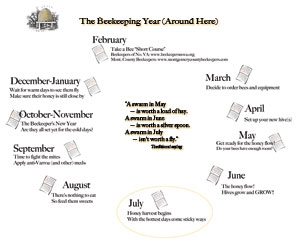 Here's a confession: this is a "pre-dated" post: as we are coming into the cold days, I seem to be slowing down, too (this post seems to be all up in my head, sorry). But here's a late update on our last presentation of the year out at the historic mill.
Here's a confession: this is a "pre-dated" post: as we are coming into the cold days, I seem to be slowing down, too (this post seems to be all up in my head, sorry). But here's a late update on our last presentation of the year out at the historic mill.On this Sunday, the folks at the Mill asked us to participate in a day of activities at the mill, where residents of that suburban county were invited to stop by and take a look at the visiting blacksmith, to tour the mill itself (which needs repair after awful floods this Spring), to talk to we-the-beekeepers, and to sample some corn bread made with grain ground at the mill and topped with the girls' honey.
Apparently, the bees are still a kind of magic draw. Fifteen minutes ahead of time, the staff said that folks were up at the general store, asking where the bees might be. We probably had 75 people move through (or so the site manager said), more than usual for an autumn event. There's so much to do around here at this time of year, it's hard to get on family schedules.
MaryEllen made a brilliant display of hive products, an observation hive, and pieces of hive equipment, once again doing all of the heavy lifting. I supplied the handout above (you can click on the picture to download a full sized copy). The mill staff had apparently not really seen us in action before, and were pretty impressed. I think we may have made a couple of beekeepers, or at least friends of bees, and it was a good way to close the outreach year.
All around the mill, signs of the holidays ahead were beginning to creep in. A professional photographer was setting up on the grounds, and we wondered why, until family after family in "weekend best" arrived and began posing for their 2006 holiday greeting cards. It is a beautiful site. Inside, every once in a while the bees would go all buzzy in the observation colony, and we got to wondering whether there was some sound, vibration, or puff of smoke from the blacksmith working just outside that they could sense and we could not.
We were on from 2 to 4, and after two hours of talking we closed up and put away as the day got dark so soon. The leaves were still on the trees, but they were heading for sundown, too.
We both agreed that a load lifted off of our minds, with no more presentations ahead until next April at the earliest, and with almost everything we could do for the bees already in the past. I still want to shake some confectioners' sugar on those mite-infested mill yard bees, but have a nagging sense that my cards really have been played.
It's just sundown around here folks, a time to sort through what you think of what's just passed, and decide what to do with the quiet.
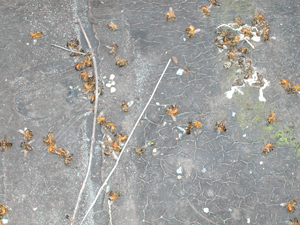 Even though it has been quiet, I look in on the roof bees everyday — hanging around near the entrance, checking on activity levels, looking to see if any deformed bees are around. You see, this time last year the roof was mysteriously covered with bees creeping aimlessly around, and it turned out that the colonies had a raving Varroa infestation.
Even though it has been quiet, I look in on the roof bees everyday — hanging around near the entrance, checking on activity levels, looking to see if any deformed bees are around. You see, this time last year the roof was mysteriously covered with bees creeping aimlessly around, and it turned out that the colonies had a raving Varroa infestation.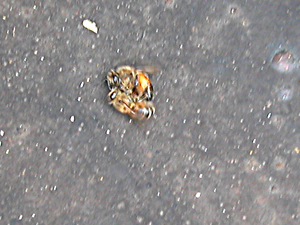 Once bees start to rob, they fight each other like the Dickens at every hive entrance. You can see them rolling around your feet like violent little honey-colored Yin/Yang symbols. They tend to persist, often because the robbing resulted from there being almost nothing else to do!
Once bees start to rob, they fight each other like the Dickens at every hive entrance. You can see them rolling around your feet like violent little honey-colored Yin/Yang symbols. They tend to persist, often because the robbing resulted from there being almost nothing else to do! 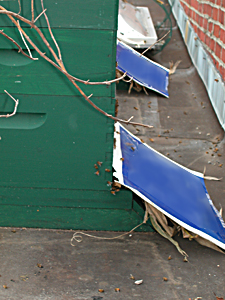 I have only one robbing screen, and two colonies, and it seemed important to balance my response so one colony would not get the advantage over the other. So I went downstairs to seek further guidance from the maarec.cas.psu.edu website, a place of great wisdom. One pamphlet there suggested throwing grass or other plant material over the reduced entrances, making them easier to defend, and/or placing a long board lengthwise across the entrance area, requiring a longer, more complicated, and (once again) more defensible approach path.
I have only one robbing screen, and two colonies, and it seemed important to balance my response so one colony would not get the advantage over the other. So I went downstairs to seek further guidance from the maarec.cas.psu.edu website, a place of great wisdom. One pamphlet there suggested throwing grass or other plant material over the reduced entrances, making them easier to defend, and/or placing a long board lengthwise across the entrance area, requiring a longer, more complicated, and (once again) more defensible approach path. 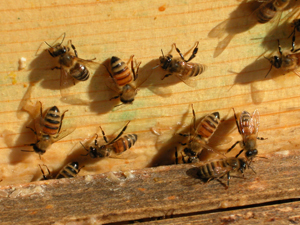 It has been a while since you got to look at a bee picture, so here you go. The year is definitely coming to a close, and my job mostly is to feed sugar syrup and take mite counts.
It has been a while since you got to look at a bee picture, so here you go. The year is definitely coming to a close, and my job mostly is to feed sugar syrup and take mite counts.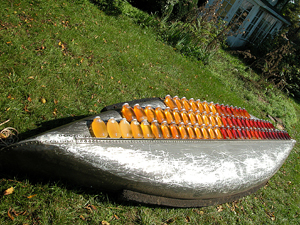 Larry from the beekeeping association ended up putting me in contact with a guy who farms more than 30 kinds of pumpkins, squash, melons, and ... bees! He needed a website for his seasonal business, so with one thing and another I ended up helping him set up satellite broadband and a wireless LAN, as well as a site. I need his permission before I can send you there, though.
Larry from the beekeeping association ended up putting me in contact with a guy who farms more than 30 kinds of pumpkins, squash, melons, and ... bees! He needed a website for his seasonal business, so with one thing and another I ended up helping him set up satellite broadband and a wireless LAN, as well as a site. I need his permission before I can send you there, though.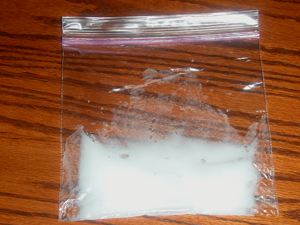 First of all, I want to tell you that the State Bee Inspector came by the historic mill on Tuesday, and he gave us the all-clear on American Foul Brood. In other words, we don't have it, or at least don't have it yet. He pointed out the big mite infestation in my hive there, though, and made various suggestions, including the use of Food Grade Mineral Oil (FGMO) to make those mites go slip-sliding away. I'll probably give it a whirl (there's no harm in it) but I have already completed two oxalic acid fumigations, and will make the third one on Monday. I think I am going to study up on how to double up on mite treatments, without unintentionally poisoning the girls with too much of a good thing.
First of all, I want to tell you that the State Bee Inspector came by the historic mill on Tuesday, and he gave us the all-clear on American Foul Brood. In other words, we don't have it, or at least don't have it yet. He pointed out the big mite infestation in my hive there, though, and made various suggestions, including the use of Food Grade Mineral Oil (FGMO) to make those mites go slip-sliding away. I'll probably give it a whirl (there's no harm in it) but I have already completed two oxalic acid fumigations, and will make the third one on Monday. I think I am going to study up on how to double up on mite treatments, without unintentionally poisoning the girls with too much of a good thing.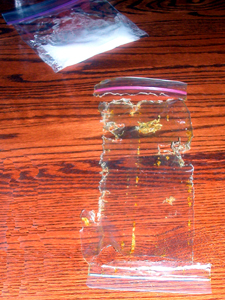 This picture shows such a bag two weeks later, The girls have cleaned it off, and actually started chewing the bag. The yellow stuff is propolis (no Carniolan party is ever complete without propolis). As of today, they got a chance to start over on a second and final dose.
This picture shows such a bag two weeks later, The girls have cleaned it off, and actually started chewing the bag. The yellow stuff is propolis (no Carniolan party is ever complete without propolis). As of today, they got a chance to start over on a second and final dose.